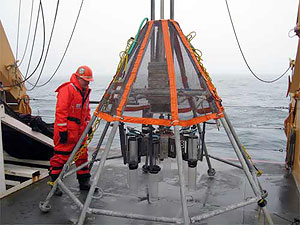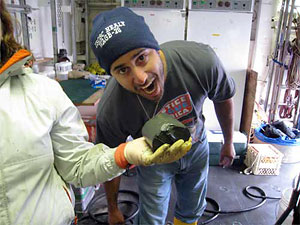

 | |||||||||||
|
|
Journals 2008/2009John Karavias
July 9, 2008 Today I decided to be on the core-sampling team. This team is led by David Shull and includes Gregg Brusseau, Heather Whitney, and Amy Cash. I have to say it was a lot of fun playing in the mud today. The amazing part if playing in the mud was: that it had never seen the light of day, could very well be thousands of years old, may have organisms never before seen by science, and makes great mud pies. Think about it folks, I had Bering Sea sediment in my hands today and still have it under my fingertips now as I type this entry. The core sample apparatus is simple yet complicated at the same time. The outer skeleton has eight legs. In the middle of it there is quite a bit of lead weight in it. Below the weight and slightly outside is the housing for the sampling tubes. Right before the apparatus goes overboard, the pins get pulled and the gravity fed weight slowly lowers the tubes. Once the legs are on the sea floor the tubes are pushed into the sediment. The apparatus stays on the floor for a few minutes to make sure this all occurs naturally. When the apparatus is picked up, the tubes come out of the sediment and the trap doors on the tubes close.
The sediment team then goes to work to decide which samples are best to take flux samples. A good flux sample then goes to the cold room that is the same temperature as the sea floor. Every day after the first day they run the overlying water trough a mass spectrometer to measure oxygen and nitrogen levels. Basically they should see oxygen consumption and nitrogen production. Then we got dirty! I stuck around for a few of the 12 sample tubes then had a long conversation with David Shull. After speaking with him, I then made my way to the whole team to ask them some questions on their capacity in the team and how they got here.
|
||||||||||

